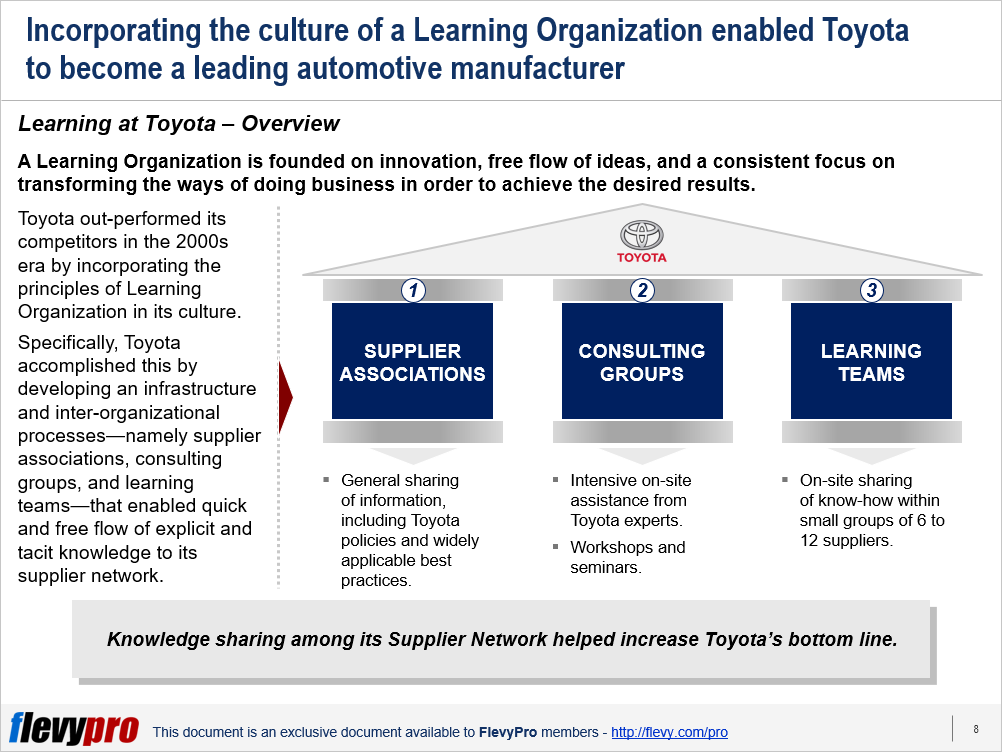Large manufacturers are often reluctant to share knowledge with suppliers. However, supplier networks are considered a great source of gaining competitive edge by Learning Organizations.
A Learning Organization is founded on innovation, free flow of ideas, and a consistent focus on transforming the ways of doing business in order to achieve the desired results. For instance, Toyota out-performed its competitors in the 2000s era by incorporating the principles of Learning Organization in its culture and sharing technology and knowledge with its suppliers. This resulted in less defects, lower inventory levels, and improved labor productivity for its suppliers and higher profits for Toyota.
Specifically, Toyota became a Learning Organization by developing the infrastructure and inter-organizational processes that enabled quick and free flow of explicit and tacit knowledge to its supplier network. The Learning Organization at Toyota features 3 inter-organizational processes, which became foundational to its approach to Supply Chain Management::
- Supplier Associations
- Consulting Groups
- Learning Teams
Let’s dive deeper into these processes.
Supplier Associations
Supplier Associations were setup by Toyota, initially, to share information, valuable experience, and to extract feedback. The knowledge-sharing mechanisms that Toyota’s Supplier Associations employ include high-level sharing of explicit knowledge within the supply network regarding production plans, policies, and market trends. The Supplier Associations hold bimonthly/monthly meetings to discuss key topics that include cost, quality, safety, best practices, and social activities.
These Supplier Associations enable suppliers to build relationships in Toyota at higher levels which was not a common practice in the industry. This resulted in tremendous improvements in supplier performance due to explicit information and experience-sharing, which ultimately benefited Toyota to achieve excellence.
Consulting Groups
By establishing Consulting Groups in the 1960s, Toyota started the practice of providing free consultation regarding valuable production knowledge to its suppliers through experts. This was accomplished through the creation of Operations Management Consulting Department (OMCD) in Japan in the 1960s and Toyota Supplier Support Center (TSSC) in the U.S. in 1992.
By developing the Consulting Groups infrastructure, Toyota’ consultants spent significant time at their supplier sites free of charge, helping them resolve problems in the Toyota Production System (TPS) implementation. Suppliers, in turn, were encouraged to share their project results and open their operations to one another. This explicit sharing of results and knowledge enabled other suppliers to replicate best practices and benefited Toyota by negotiating Target Pricing with its suppliers.
Learning Teams
Learning Teams—the 3rd pillar of a Learning Organization—were pioneered by Toyota in 1977 by organizing its suppliers into Voluntary Study Groups in Japan or Plant Development Activity (PDA) groups in the U.S. The Learning Team collaborated voluntarily on production and quality management.
The Learning Teams were—and still are—responsible for determining a theme and spending time addressing each member’s problems related to that theme, making the members learn significantly by having outside pair of eyes look at their problems. This helped Toyota’s suppliers’ network achieve effective tacit knowledge transfer, explore new ideas and applications of Toyota Production System (TPS), transfer valuable lessons learnt to all stakeholders, and enhance production quality.
Toyota follows a deliberate step-wise path to create Knowledge-Sharing Networks. These Knowledge-Sharing Networks are an invaluable resource for enhancing both overt and implicit information and experiences for the organization.
Key dynamics of Toyota’s Knowledge-Sharing Networks involve creating a non-threatening one-on-one relationship with suppliers through the Suppliers Association in the form of financial as well as valuable knowledge-sharing assistance.
Interested in learning more about the dynamics of Toyota’s Knowledge-Sharing Networks, the fundamental barriers to learning, and their implications on the suppliers and the manufacturer? You can download an editable PowerPoint on Learning Organization: Supplier Networks here on the Flevy documents marketplace.
Are you a Management Consultant?
You can download this and hundreds of other consulting frameworks and consulting training guides from the FlevyPro library.

Comments
The simplest way to grasp the distinction between machine learning and deep learning is to realize that deep learning equals machine learning. Deep learning is a step forward in the advancement of machine learning. It makes use of a programmable neural network, which allows robots to make accurate judgments without the need for human intervention. Grab an opportunity to learn Data science courses in Bangalore at Learnbay.